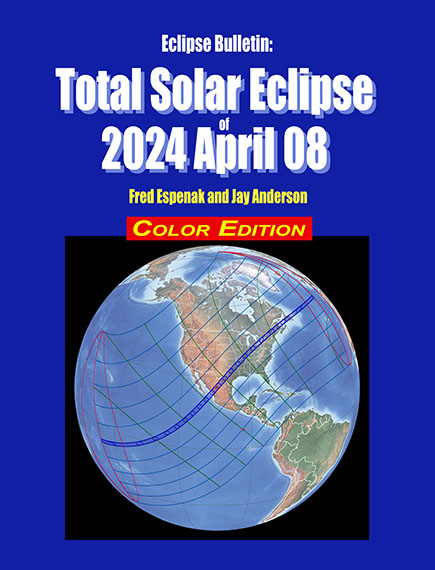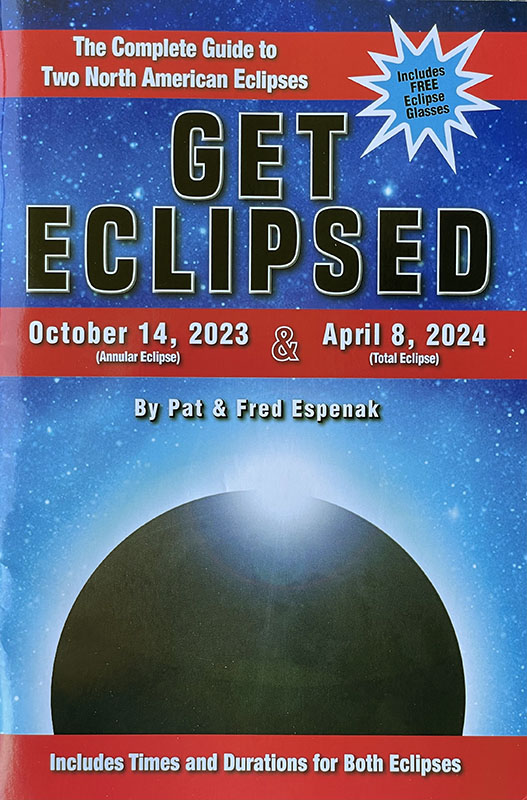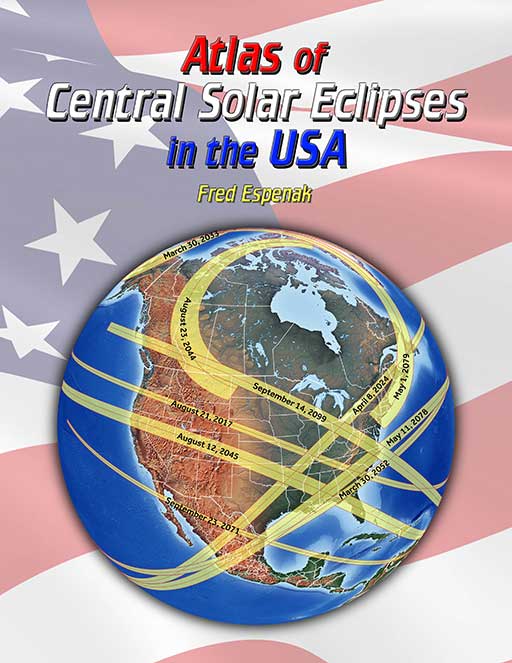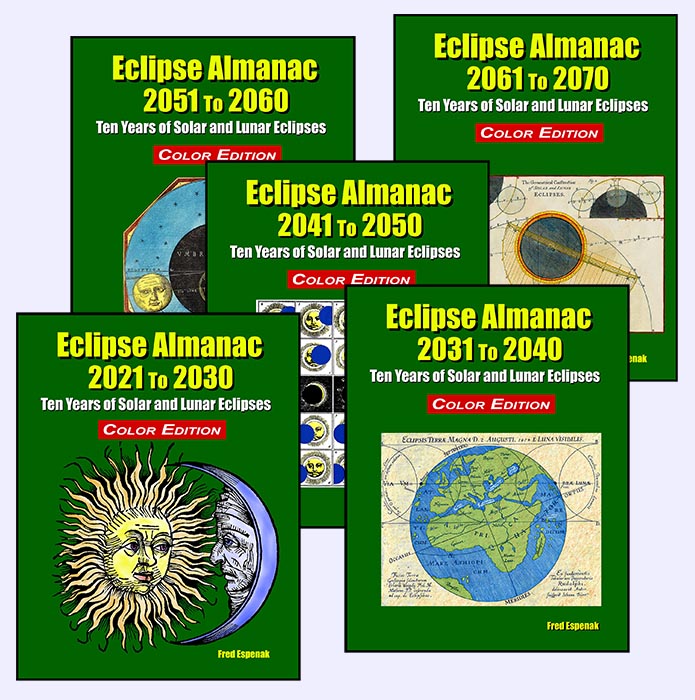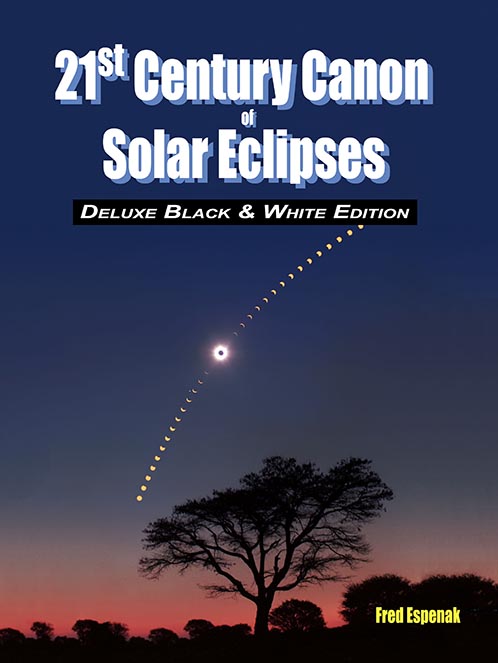The Experience of Totality
Adapted from 'Totality: The Great American Eclipses of 2017 and 2024'

2017 Total Solar Eclipse
This sequence shows the entire eclipse from start to finish.
(click to see more photos)
-
"Some people see a partial eclipse and wonder why others talk so much about a total eclipse.
Seeing a partial eclipse and saying that you have seen an eclipse is like standing outside an opera house and saying that you have seen the opera;
in both cases, you have missed the main event."
Jay M. Pasachoff (1983)
First contact. A tiny nick appears on the western side of the Sun. The eye detects no difference in the amount of sunlight. Nothing but that nick portends anything out of the ordinary. But as the nick becomes a gouge in the face of the Sun, a sense of anticipation begins. This will be no ordinary day.
Still, things proceed leisurely for the first half hour or so, until the Sun is more than half covered. Now, gradually at first, then faster and faster, extraordinary things begin to happen. The sky is still bright, but the blue is a little duller. On the ground around you the light is beginning to diminish. Over the next 10 to 15 minutes, the landscape takes on a steely gray metallic cast.
As the minutes pass, the pace quickens. With about a quarter hour left until totality, the western sky is now darker than the east, regard less of where the Sun is in the sky. The shadow of the Moon is approaching. Even if you have never seen a total eclipse of the Sun before, you know that something amazing is going to happen, is happening now--and that it is beyond normal human experience.
Less than fifteen minutes until totality. The Sun, a narrowing crescent, is still fiercely bright, but the blueness of the sky has deepened into blue-gray or violet. The darkness of the sky begins to close in around the Sun. The Sun does not fill the heavens with brightness anymore.
Five minutes to totality. The darkness in the west is very noticeable and gathering strength, a dark amorphous form rising upward and spreading out along the western horizon. It builds like a massive storm, but in utter silence, with no rumble of distant thunder. And now the darkness begins to float up above the horizon, revealing a yellow or orange twilight beneath. You are already seeing through the Moon's narrow shadow to the resurgent sunlight beyond.
The acceleration of events intensifies. The crescent Sun is now a blazing white sliver, like a welder's torch. The darkening sky continues to close in around the Sun, faster, engulfing it.
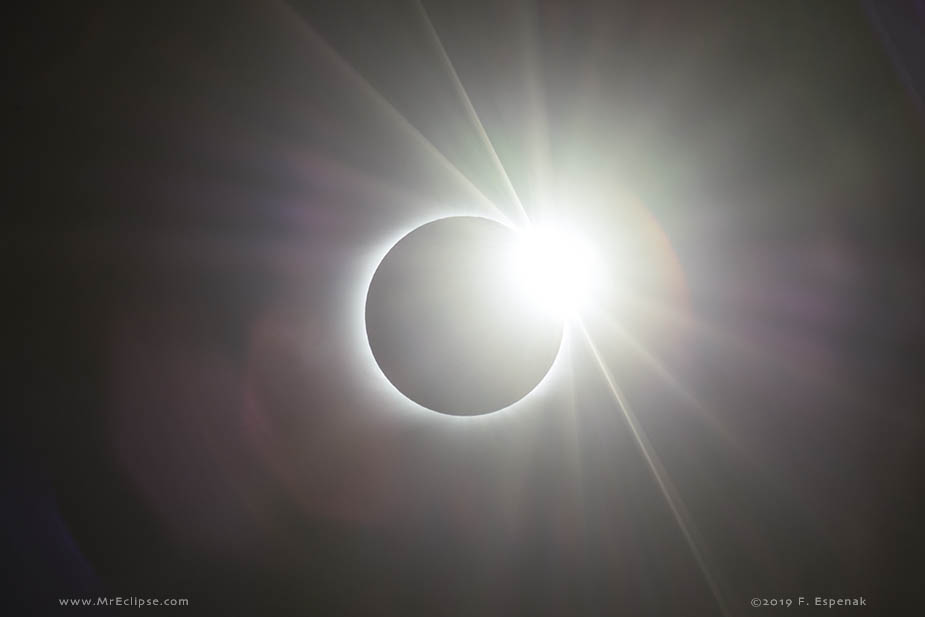
2019 Diamond Ring Effect
The "diamong ring" effect is seen just before totality begins.
(click to see more photos)
Minutes have become seconds. The ends of the bare sliver of the Sun break into individual points of intense white light--Baily's Beads--the last rays of sunlight passing through the deepest lunar valleys. Opposite the crescent, a ghostly round silhouette looms into view. It is the dark limb of the Moon, framed by a white opalescent glow which creates a halo around the darkened Sun. The corona--the most striking and unexpected of all the features of a total eclipse--is emerging.
Almost instantaneously, the incredibly thin crescent Sun fragments into a series of brilliant beads and short arcs which dwindle and vanish in rapid succession. And now, there is only one bead, set like a single dazzling diamond in a ring."
But its penetrating brilliance rapidly fades as if it were sucked into an abyss.
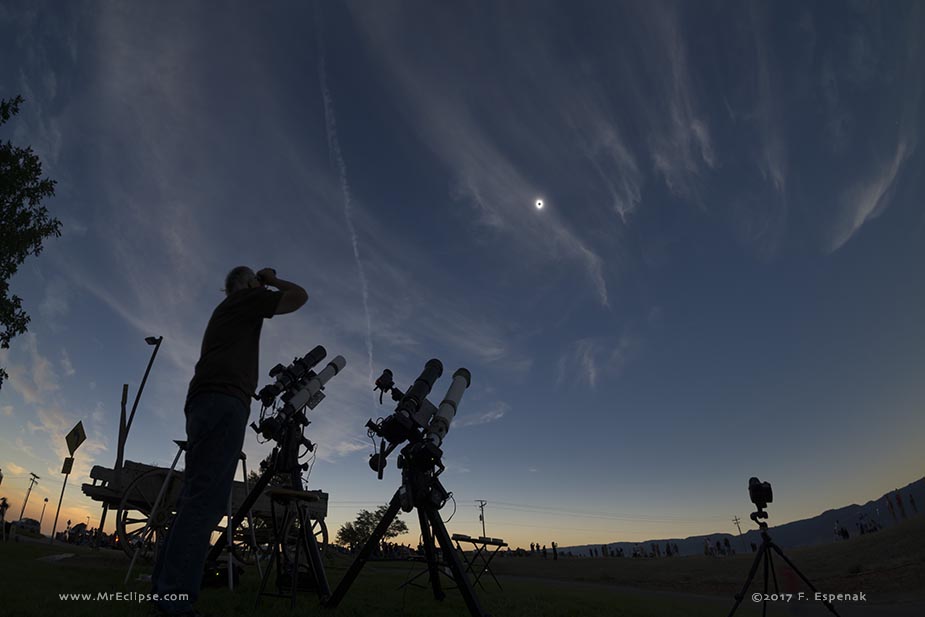
2017 Total Solar Eclipse
This sequence shows the entire eclipse from start to finish.
(click to see more photos)
Totality!
Where the Sun once stood, there is a black disk in the sky, outlined by the soft pearly white glow of the corona, about the brightness of a Full Moon. Small but vibrant reddish features stand at the eastern rim of the Moon's disk, contrasting vividly with the white of the corona and the black where the Sun is hidden. These are the prominences, giant clouds of hot gas in the Sun's lower atmosphere. They are always a surprise, each unique in shape and size, different yesterday and tomorrow from what they are at this special moment.
You are standing in the shadow of the Moon.
It is dark enough to see Venus and Mercury and whichever of the brightest planets and stars happen to be close to the Sun's position and above the horizon. But it is not the dark of night. Looking across the landscape at the horizon in all directions, you see beyond the shadow to where the eclipse is not total, an eerie twilight of orange and yellow. From this light beyond the darkness which envelops you comes an inexorable sense that time is limited.
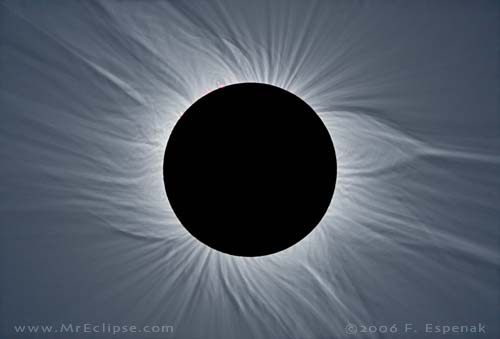
2006 Total Solar Eclipse
A composite image reveals subtle structure in the Sun's corona.
(click to see more photos)
Now, at the midpoint in totality, the corona stands out most clearly, its shape and extent never quite the same from one eclipse to another. And only the eye can do the corona justice, its special pattern of faint wisps and spikes on this day never seen before and never to be seen again.
Yet around you at the horizon is a warning that totality is drawing to an end. The west is brightening while in the east the darkness is deepening and descending toward the horizon. Above you, prominences appear at the western edge of the Moon. The edge brightens.
Suddenly totality is over! A brilliant bead of sunlight appears. This heavenly diamond quickly grows into a band of several jewels which merge together to form the returning crescent Sun. The dark shadow of the Moon silently slips past you and rushes off toward the east.
-
The description of Totality appearing above is adapted from
Totality - The Great American Eclipses of 2017 and 2024.
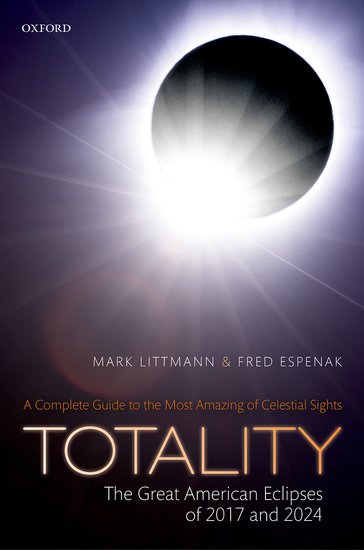
Totality - The Great American Eclipses of 2017 and 2024
©2016 by Mark Littmann and Fred Espenak
Totality - The Great American Eclipses of 2017 and 2024 is a complete guide to the most stunning of celestial sights, total eclipses of the Sun. It focuses on the eclipses of August 21, 2017 and April 8, 2024 that pass across the United States. The U.S. mainland has not experienced a total solar eclipse since 1979. This book provides information, photographs, and illustrations to help the public understand and safely enjoy all aspects of these eclipses including:
- How to observe a total eclipse of the Sun
- How to photograph and video record an eclipse
- Why solar eclipses happen
- The earliest attempts to understand and predict eclipses
- The mythology and folklore of eclipses
- The response of animals to total solar eclipses
- The response of man to total eclipses through time
- How scientists used total eclipses to understand how the Sun works
- How astronomers used a total solar eclipse in 1919 to confirm Einstein's general theory of relativity
- Weather prospects for the 2017 eclipse
- Detailed maps of the path of totality for the 2017 eclipse and the eclipses of 2018 through 2024
- Precise local times for the eclipses of 2017 and 2024 (the next total solar eclipse to visit the U.S.)
- Color and black-and-white photographs, diagrams, and charts to illustrate and explain total solar eclipses
- Global maps of total solar eclipses from 2017 to 2045 and lists of total and annual solar eclipses from 1970 through 2070
Table of Contents
- 1: The Experience of Totality
- 2: The Great Celestial Cover-Up
- 3: Ancient Efforts to Understand
- 4: Eclipses in Mythology
- 5: The Strange Behavior of Man and Beast - Long Ago
- 6: The Sun at Work
- 7: The First Eclipse Chasers
- 8: The Eclipse that Made Einstein Famous
- 9: Observing a Total Eclipse
- 10: Eye Safety During Solar Eclipses
- 11: The Strange Behavior of Man and Beast - Modern Times
- 12: Eclipse Photography
- 13: The All-American Eclipse of 2017
- 14: The Weather Outlook
- 15: When Is the Next One? Total Eclipses: 2018-2023
- 16: Coming Back to America: The Eclipse of 2024
- 17: Epilogue
- Appendix A: Maps for Every Solar Eclipse 2017-2045
- Appendix B: Total, Annular, and Hybrid Eclipses: 2017-2060
- Appendix C: Recent Total, Annular, and Hybrid Eclipses: 1970-2016
- Appendix D: Total Eclipses in the United States: 1492 to 2100
About the Authors
Mark Littmann, Professor, University of Tennessee, Knoxville, and Fred Espenak, Astrophysicist emeritus, NASA - Goddard Space Flight Center.
Mark Littmann has written several popular books about astronomy. Planets Beyond: Discovering the Outer Solar System won the Science Writing Award of the American Institute of Physics. Planet Halley: Once in a Lifetime (Donald K Yeomans, co-author) won the Elliott Montroll Special Award of the New York Academy of Sciences. Reviewers described The Heavens on Fire: The Great Leonid Meteor Storms as a "unique achievement," "altogether satisfying," and "a compelling read." Mark holds an endowed professorship, the Hill Chair of Excellence in Science Writing, at the University of Tennessee where he teaches three different courses in writing about science, technology, medicine, and the environment. He has helped lead expeditions to Canada, Hawaii, Bolivia, Aruba, and Turkey to observe total eclipses.
Fred Espenak is the most widely recognized name in solar eclipses.
He is a scientisit emeritus at NASA's Goddard Space Flight Center, where he founded and runs the NASA Eclipse Home Page <
Also Available!
Road Atlas for the Total Solar Eclipse of 2024
The Road Atlas for the Total Solar Eclipse of 2024 contains a comprehensive series of 26 maps of the path of totality across Mexico, the USA and Canada. The large scale (1 inch ≈ 22 miles) shows both major and minor roads, towns and cities, rivers, parks, and mountains.
Although a partial eclipse will be seen from all of North America, the total phase in which the Moon completely covers the Sun (known as totality) will only be seen from within the 120-mile-wide path of the Moon’s umbral shadow as it sweeps across Mexico, the United States (Texas, Oklahoma, Arkansas, Missouri, Tennessee, Kentucky, Illinois, Indiana, Ohio, Michigan, Pennsylvania, New York, Vermont, New Hampshire, and Maine), and Canada (Ontario, Quebec, New Brunswick, Prince Edward Island, Nova Scotia and Newfoundland).
Armed with this atlas and the latest weather forecasts, the road warrior is ready to chase totality no matter where it takes him/her along the entire path. This mobile strategy offers the highest probability of witnessing the spectacular 2024 total eclipse in clear skies.
For more information visit Road Atlas for the Total Solar Eclipse of 2024 .
Eclipse Bulletin: Total Solar Eclipse of 2024 April 08
The Eclipse Bulletin: Total Solar Eclipse of 2024 April 08 is the complementary publication of the 2024 Road Atlas and is the ultimate guide to this highly anticipated event.
Eleven high resolution maps plot the total eclipse track across Mexico, the USA, and Canada. The large map scale (1 inch ≈ 53 miles) shows hundreds of cities and towns in the path, the location of major roads and highways, and the duration of totality with distance from the central line. Local circumstances tables for hundreds cities the USA, Canada, and Mexico provide times of each phase of the eclipse along with the eclipse magnitude, duration and Sun's altitude. A detailed climatological study identifies areas along the eclipse path where the highest probability of favorable weather may be found.
Finally, comprehensive information is presented about solar filters and how to safely observe the eclipse.
For more information visit Eclipse Bulletin: Total Solar Eclipse of 2024 April 08 .
Get Eclipsed: A Family Guide to Two North American Eclipses
North America will be the scene for two spectacular eclipses of the Sun. On October 14, 2023 , an annular eclipse of the Sun occurs in western USA and Mexico. Six months later, an incomparable total eclipse of the Sun occurs on April 8, 2024 . Its 125-mile wide path crosses Mexico, the USA from Texas to Maine, and eastern Canada.
During both of these events, a partial eclipse of the Sun will be visible from virtually all of North America. The last annular eclipse visible from the USA was in 2012. The last total eclipse visible from the USA was in 2017, and the next one to cross the country won't be until 2044. Don't miss the incredible experience of seeing these celestial wonders!
Get Eclipsed is an easy to read, family friendly, inexpensive eclipse guide for the entire family. It tells you everything you need to know about the upcoming annular and total eclipses of the Sun in 2023 and 2024. And it comes with two pairs of special glasses for safely watching the partial eclipse phases and annularity.
For more information visit Get Eclipsed .
Atlas of Central Solar Eclipses in the USA
The Atlas of Central Solar Eclipses in the USA contains of a series of 499 global maps showing the geographic track of every total and annular solar eclipse across the USA (including Alaska and Hawaii) during the two-thousand-year period 1001 through 3000. It is accompanied by a catalog that lists the major characteristics of each eclipse including its duration and whether it is visible from the lower 48 states, Alaska and/or Hawaii.
A set of 20 detailed maps, each covering a 50-year period and centered on the lower 48 states, shows the path of every total and annular eclipse. The maps include state boundaries and major cities. These maps also cover southern Canada and northern Mexico.
For more information visit Atlas of Central Solar Eclipses in the USA .
Eclipse Almanac
The Eclipse Almanac is a series of five publications. Each one is a concise reference for every eclipse of the Sun and the Moon over a 10-year period. This compendium identifies when and where each of these events will be seen. Particular details about each eclipse are included, as well as a 25-year table looking further into the future.
Section 1 presents solar eclipses including an explanation of why they occur, types of solar eclipses, and the visual appearance of each. Global maps depict the geographic regions of visibility of each of the 22 to 23 solar eclipses.
Section 2 covers lunar eclipses explaning why they occur, the types of lunar eclipses, and the appearance of each. Detailed figures illustrate each of the 22 to 23 lunar eclipses including the Moon's path through Earth's shadows, and a map of the geographic visibility of every eclipse.
Section 3 lists the date and time of the Moon’s phases over the decade.
The five volume Eclipse Almanac series covers the decades from 2021 to 2070.
For more information visit Eclipse Almanac .
21st Century Canon of Solar Eclipses
The 21st Century Canon of Solar Eclipses contains maps and data for all 224 solar eclipses occurring during the 100-year period from 2001 through 2100. The eclipse predictions are based on the Jet Propulsion Lab's DE405 - a computer ephemeris used for calculating high precision coordinates of the Sun and Moon for hundreds of years into the past and future.
Section 1 of the Canon presents the fundamentals about solar eclipses. Section 2 discusses the eclipse the predictions, the constants used. A statistical analysis of eclipse frequency, extremes in eclipse magnitude, greatest central duration and quincena combinations are covered in Section 3. A concise explanation of the data contained in the solar eclipse catalog (Appendix A) and detailed descriptions of the solar eclipse maps.
The primary content of the "21st Century Canon" resides in the four appendices. Appendix A is a comprehensive catalog of solar eclipses. Appendix B is an atlas of maps (12 per page) depicting the geographic regions of visibility of each eclipse. Appendix C zeros in on full-page maps each solar eclipse. Curves of Maximum Time and Curves of Eclipse Magnitude permit the estimation of time and magnitude from any geographic location. Finally, Appendix D plots the track of every central eclipse (total, annular and hybrid) on large scale maps to allow the identification of countries and major cities within each eclipse path.
For more information visit 21st Century Canon of Solar Eclipses .




